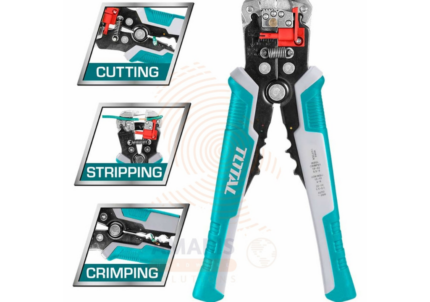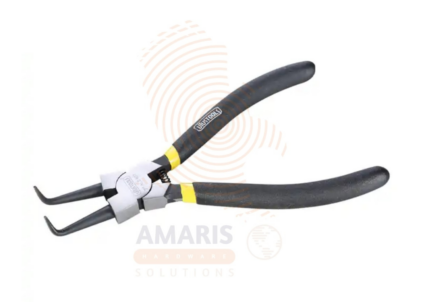Back to products


Digital Vernier Caliper
$34.23 Original price was: $34.23.$32.52Current price is: $32.52.
Digital Multi-Purpose Clamp Meters
WhatsApp Order
A digital multi-purpose clamp meter is a versatile electronic measuring instrument designed to measure electrical current by clamping around a conductor, typically without the need to disconnect the circuit. It combines the functionalities of a digital multi meter with the convenience of a clamp to accurately measure AC and DC currents, voltage, resistance, capacitance, frequency, and other electrical parameters in various applications. The clamp feature allows for non-invasive current measurements, making it suitable for both professionals and hobbyists in fields such as electrical maintenance, troubleshooting, and testing.
Description
Uses of DIGITAL MULTI- PURPOSE CLAMP METER
- Measuring Current: The primary function of a clamp meter is to measure electrical current. It can accurately measure both AC (alternating current) and DC (direct current) without the need to interrupt the circuit.
- Non-Invasive Current Measurements: The clamp feature allows for non-contact or non-invasive current measurements by clamping around a conductor, making it convenient and safe for technicians.
- Voltage Measurement: Clamp meters can measure AC and DC voltage levels in circuits. This is useful for troubleshooting and verifying the voltage in electrical systems.
- Resistance Measurement: These meters can measure the resistance of electrical components, helping technicians identify faulty or damaged elements in a circuit.
- Continuity Testing: Many clamp meters have a continuity testing function, which helps in quickly identifying the continuity of a circuit by producing an audible beep for a low-resistance path.
- Capacitance Measurement: Some clamp meters come equipped with the capability to measure capacitance, allowing technicians to assess the health of capacitors in electronic circuits.
- Frequency Measurement: Clamp meters can measure the frequency of AC signals, which is useful in various applications, especially in troubleshooting electronic circuits.
- Temperature Measurement: Certain models of clamp meters are equipped with a temperature measurement feature, enabling users to measure the temperature of electrical components.
- Power Measurement: Advanced clamp meters may have features for measuring power factors, active power, and apparent power in electrical systems, providing a comprehensive analysis of power consumption.
- Harmonic Analysis: In some models, there are features for harmonic analysis, allowing technicians to assess and troubleshoot harmonic distortions in electrical systems.
- Phase Rotation Testing: Certain clamp meters are designed to determine the direction of phase rotation in three-phase systems, ensuring proper connection of electrical equipment.
- Data Logging and Recording: Some advanced clamp meters offer data logging capabilities, allowing users to record measurements over time for further analysis and documentation.
SAFETY HANDLING PRECAUTIONS
- Personal Protective Equipment (PPE):
- Always wear appropriate personal protective equipment, including safety glasses and insulated gloves, to protect yourself from potential electrical hazards.
- Inspect the Meter:
- Before use, inspect the clamp meter for any visible damage or defects. Ensure that the test leads, clamps, and other components are in good condition.
- Use the Right Range:
- Select the appropriate measurement range for the parameter you are measuring (voltage, current, resistance, etc.). Using the correct range ensures accurate readings and prevents potential damage to the meter.
- Verify Functionality:
- Before making measurements, verify that the clamp meter is functioning properly. Check the meter's self-test function if available.
- Insulated Handles:
- Ensure that the handles and grips of the clamp meter are insulated. This helps prevent electric shock and ensures your safety while handling the instrument.
- Turn Off Power:
- Before connecting or disconnecting the clamp meter, turn off the power to the circuit being measured. This reduces the risk of electrical shock and damage to the meter.
- De-Energize the Circuit:
- Whenever possible, de-energize the circuit before making measurements. This minimizes the risk of electrical shock and protects the meter from potential overloads.
- Secure Connections:
- Ensure that all connections are secure and properly attached. Loose connections can lead to inaccurate readings, and in worst cases, they can cause arcing or sparks.
- Avoid High Voltage:
- Do not use the clamp meter on circuits with voltages higher than the meter's rating. Exceeding the voltage rating can damage the meter and pose a significant safety risk.
- Follow Manufacturer's Instructions:
- Adhere to the manufacturer's instructions and guidelines for using the clamp meter. This includes information on operating conditions, maintenance, and any specific safety precautions.
- Beware of Magnetic Fields:
- Be cautious when using the clamp feature around magnetic fields, as it may affect the accuracy of the readings. Refer to the manufacturer's guidelines for specific recommendations.
- Stay Alert:
- Maintain focus and stay alert while using the clamp meter. Avoid distractions to ensure accurate measurements and reduce the risk of accidents.
- Proper Storage:
- When not in use, store the clamp meter in a safe and dry place. Protect it from extreme temperatures, moisture, and physical damage.
Related products
Automatic Wire Stripper
An automatic wire stripper is a specialized tool designed for efficiently and precisely removing the insulation or sheathing from electrical wires. It typically features adjustable cutting blades or jaws that can be set to the appropriate wire gauge, allowing for the quick and accurate stripping of insulation without damaging the underlying conductive wire. Automatic wire strippers are widely used in electrical and electronics work, automating the process of stripping insulation from wires and enhancing efficiency in tasks such as wiring, soldering, or crimping connections.
C Clamp Locking Pliers
A C clamp locking pliers, often simply referred to as locking pliers or Vise-Grips (a popular brand name), is a versatile hand tool designed for gripping, clamping, and holding objects securely. The tool features an adjustable locking mechanism that allows it to maintain a constant grip force on the object, freeing the user's hands for other tasks. The jaws of the pliers are shaped like a C-clamp, providing a strong and secure grip on various shapes and sizes of objects. This makes C clamp locking pliers particularly useful in situations where a stable hold is required, such as in woodworking, metalworking, automotive repair, and general DIY applications.
Cement Blender
A cement blender is a mechanical device designed for the purpose of mixing and blending various components of cementitious materials, such as cement, sand, and water, to create a homogenous mixture. This blended mixture is commonly used in construction and building projects, particularly for applications like concrete production. The blender typically features a rotating drum or container that facilitates the thorough mixing of the ingredients, ensuring a consistent and uniform composition for the construction materials.
Cement Blender – SDS Plus
A cement blender with an SDS-PLUS mechanism typically refers to a power tool designed for mixing cement, mortar, or other construction materials. The term "SDS-PLUS" refers to a specific chuck and bit system commonly used in rotary hammers and drills. SDS-PLUS chucks allow for quick and secure attachment of drill bits and other accessories.
In the context of a cement blender with SDS-PLUS, it likely means that the tool has a specialized chuck system for easy attachment of mixing paddles or blades used in blending cement or similar materials. The SDS-PLUS system is known for its quick-change capability, enhancing efficiency and convenience when working with different attachments. The blender's design may include features to ensure effective mixing of construction materials, making it suitable for tasks like preparing mortar or concrete on construction sites.
Chalk Line Reel Set
A Chalk Line Reel Set typically refers to a package or kit that includes two chalk line reels. A chalk line reel is a tool used in construction and carpentry for marking straight and level lines on surfaces such as walls, floors, and ceilings. The set usually includes two individual chalk line reels, each consisting of a housing containing a length of string or cord coated with chalk powder.
The process involves stretching the string between two points, snapping it against the surface to leave a straight chalk line, which serves as a guide for various construction or layout tasks. Having two chalk line reels in a set can be convenient for projects that require multiple reference lines or for situations where two people are working simultaneously. This set often includes chalk powder or chalk cartridges that can be loaded into the reels for marking the lines.
Electronic Wire Stripper
PRODUCT DESCRIPTION
An electronic wire stripper is a specialized handheld tool designed for efficiently and accurately removing the insulation or outer covering from electrical wires. It incorporates motorized or automated mechanisms to cut through and strip the insulation without damaging the underlying conductive wire. This tool is commonly used in electrical and electronic applications to streamline the process of preparing wires for connection, ensuring precision and reducing the risk of damage to the wire during the stripping process.
External Circlip Pliers Bent
External circlip pliers – bent refer to a specialized hand tool designed for the installation and removal of external circlips. A circlip, also known as a retaining ring or snap ring, is a type of fastener or retaining device that fits into a groove on a cylindrical object, such as a shaft or a bore. External circlips are positioned on the outside of the shaft or bore.
The term "bent" in the context of external circlip pliers describes the shape of the tool. These pliers typically have angled or bent tips that allow for easier access to the external circlip, especially in tight or confined spaces. The bent design helps the user reach and manipulate the circlip more effectively, providing improved maneuverability during installation or removal.
Mini Digital Multi-Meter
PRODUCT DESCRIPTION
A mini digital multi meter is a compact and portable electronic measuring instrument that combines several essential measurement functions into a single device. It typically includes features such as voltage measurement, current measurement, resistance measurement, and often additional functions like diode testing and continuity checking. The "mini" designation implies that it is smaller in size compared to standard multi meters, making it convenient for use in tight spaces or for on-the-go applications. The "digital" aspect indicates that it displays measurements using a digital numerical readout, offering accuracy and ease of reading compared to analog meters. These devices are commonly used by technicians, hobbyists, and professionals to troubleshoot, test, and measure electrical parameters in various applications.


 Acrylic Sealants
Acrylic Sealants Construction Adhesives
Construction Adhesives Double-Sided Tape
Double-Sided Tape Duct Tape
Duct Tape Electrical Tape
Electrical Tape Epoxy & Resins
Epoxy & Resins Masking Tape
Masking Tape
 Automotive Wrenches & Socket Sets
Automotive Wrenches & Socket Sets Battery Chargers & Jump Starters
Battery Chargers & Jump Starters Car Jacks & Stands
Car Jacks & Stands Car Wash & Detailing Products
Car Wash & Detailing Products Diagnostic Tools
Diagnostic Tools Tire Inflators
Tire Inflators Vehicle Lighting
Vehicle Lighting Oil & Lubricants
Oil & Lubricants
 Adhesives & Sealants
Adhesives & Sealants Bricks & Blocks
Bricks & Blocks Cement & Concrete
Cement & Concrete Drywall & Plaster
Drywall & Plaster Flooring (Tiles, Wood, Laminate)
Flooring (Tiles, Wood, Laminate) Lumber & Plywood
Lumber & Plywood Paints, Primers & Coatings
Paints, Primers & Coatings Insulation Materials
Insulation Materials Roofing Materials
Roofing Materials
 Circuit Breakers
Circuit Breakers Electrical Cables & Wires
Electrical Cables & Wires Switches & Sockets
Switches & Sockets Fuses & Relays
Fuses & Relays Connectors & Terminals
Connectors & Terminals Electrical Boxes & Panels
Electrical Boxes & Panels Conduit & Fittings
Conduit & Fittings Lighting Fixtures & Bulbs
Lighting Fixtures & Bulbs Extension Cords & Power Strips
Extension Cords & Power Strips
 Anchors
Anchors Bolts
Bolts Clips & Clamps
Clips & Clamps Screws
Screws Nuts
Nuts Washers
Washers Rivets
Rivets Nails
Nails Threaded Rods
Threaded Rods
 Hammers
Hammers Measuring Tools (Tapes, Levels, Calipers)
Measuring Tools (Tapes, Levels, Calipers) Screwdrivers
Screwdrivers Pliers & Cutters
Pliers & Cutters Saws & Blades
Saws & Blades Chisels & Punches
Chisels & Punches Allen Keys & Hex Keys
Allen Keys & Hex Keys Ratchets & Socket Sets
Ratchets & Socket Sets Wrenches & Spanners
Wrenches & Spanners
 Power Tool Accessories (Blades, Bits, Discs)
Power Tool Accessories (Blades, Bits, Discs) Rotary Tools
Rotary Tools Saws (Circular, Jigsaw, Reciprocating)
Saws (Circular, Jigsaw, Reciprocating) Drills & Drivers
Drills & Drivers Grinders & Sanders
Grinders & Sanders Heat Guns
Heat Guns Nail Guns
Nail Guns Impact Wrenches
Impact Wrenches Batteries & Chargers
Batteries & Chargers
 Pipes & Fittings (PVC, Copper, PEX)
Pipes & Fittings (PVC, Copper, PEX) Plumbing Tools
Plumbing Tools Pumps & Motors
Pumps & Motors Sealants & Adhesives for Plumbing
Sealants & Adhesives for Plumbing Valves & Taps
Valves & Taps Water Heaters
Water Heaters Drainage Systems
Drainage Systems Faucets & Fixtures
Faucets & Fixtures Hoses & Tubing
Hoses & Tubing
 Hinges & Latches
Hinges & Latches Hooks & Brackets
Hooks & Brackets Window Hardware
Window Hardware Chains & Cables
Chains & Cables Casters & Wheels
Casters & Wheels Shelving & Storage Systems
Shelving & Storage Systems Door Handles & Locks
Door Handles & Locks Drawer Slides & Cabinet Hardware
Drawer Slides & Cabinet Hardware
 Personal Protective Equipment (PPE)
Personal Protective Equipment (PPE) Respirators & Masks
Respirators & Masks Safety Glasses
Safety Glasses Safes
Safes Security Cameras
Security Cameras Gloves
Gloves Helmets
Helmets Ear Protection
Ear Protection Fire Safety Equipment
Fire Safety Equipment Locks & Padlocks
Locks & Padlocks Motion Sensors & Alarms
Motion Sensors & Alarms
 Garden Fencing
Garden Fencing Garden Furniture Hardware
Garden Furniture Hardware Lawn Mowers
Lawn Mowers Trimmers & Edgers
Trimmers & Edgers Shovels & Spades
Shovels & Spades Rakes & Hoes
Rakes & Hoes Pruning Shears & Loppers
Pruning Shears & Loppers Watering Systems (Hoses, Sprinklers, Nozzles)
Watering Systems (Hoses, Sprinklers, Nozzles)
 Interior Paints
Interior Paints Paint Brushes & Rollers
Paint Brushes & Rollers Paint Strippers & Thinners
Paint Strippers & Thinners Paint Trays & Accessories
Paint Trays & Accessories Exterior Paints
Exterior Paints Spray Paints
Spray Paints Primers & Undercoats
Primers & Undercoats Varnishes & Stains
Varnishes & Stains
 Gaskets & Seals
Gaskets & Seals Hydraulic Fittings
Hydraulic Fittings Industrial Fasteners
Industrial Fasteners Industrial Hoses
Industrial Hoses Lubricants & Greases
Lubricants & Greases Metal Sheets & Bars
Metal Sheets & Bars Bearings & Bushings
Bearings & Bushings Belts & Pulleys
Belts & Pulleys
 HVAC Filters
HVAC Filters Insulation for HVAC
Insulation for HVAC Air Conditioners
Air Conditioners Refrigerants
Refrigerants Ventilation Ducts & Fittings
Ventilation Ducts & Fittings Thermostats & Controllers
Thermostats & Controllers Fans & Blowers
Fans & Blowers
 Pegboards & Hooks
Pegboards & Hooks Shelving Units
Shelving Units Storage Bins & Containers
Storage Bins & Containers Toolboxes & Tool Chests
Toolboxes & Tool Chests Workbenches
Workbenches Drawer Organizers
Drawer Organizers Labeling Supplies
Labeling Supplies
 Welding Accessories (Clamps, Brushes)
Welding Accessories (Clamps, Brushes) Welding Electrodes & Rods
Welding Electrodes & Rods Welding Helmets & Gloves
Welding Helmets & Gloves Welding Machines
Welding Machines Soldering Irons & Stations
Soldering Irons & Stations Flux & Solder Wire
Flux & Solder Wire
 Generator Accessories
Generator Accessories Inverters
Inverters Portable Generators
Portable Generators Power Inverters
Power Inverters Transfer Switches
Transfer Switches Diesel & Gasoline Generators
Diesel & Gasoline Generators
 Transport Equipment: Carts, Dollies, and Hand Trucks
Transport Equipment: Carts, Dollies, and Hand Trucks Storage Solutions: Pallets, Racks, and Containers
Storage Solutions: Pallets, Racks, and Containers Lifting Equipment: Hoists, Cranes, and Jacks
Lifting Equipment: Hoists, Cranes, and Jacks Conveyors and Accessories: Belts and Rollers
Conveyors and Accessories: Belts and Rollers








